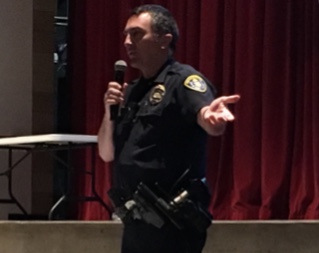CCHS adopts “opt-in” drug testing
Program encourages tough conversations between students and parents

Officer Bob Briggs of the San Diego Police Department discusses the trends in teen drug use, the success of rehabilitation programs, and the dangers of vape and other commonly used drugs at a parent alcohol and drug awareness meeting on Oct. 30. The meeting was the final meeting of a series that took place since August.
Cathedral Catholic High School will implement an “opt-in” drug and alcohol testing program this school year as a way to provide parents the option to test randomly and periodically their child for illicit substances.
Only one year removed from the attempted institution, but ultimate delaying, of mandatory student drug testing, the opt-in program fosters the same goal of curbing student drug use.
“At one of the drug and alcohol awareness meetings, a parent walked up to me and asked, ‘Why not offer [the drug testing program] as an opt-in and let parents choose,’ ” CCHS principal Dr. Kevin Calkins said.
Although some details of the policy still are being finalized, the major aspects include a hair follicle examination testing for drug use, a cheek swab testing for alcohol, a restorative discipline approach, and an ability to opt-out.
The primary difference between this year’s policy and last year’s aborted one is the optional nature, which administrators believe lessens the punisher relationship the school would present through the program.
“If someone comes back with a positive test,” Dr. Calkins said, “the diocese wants to make sure that it is not zero tolerance and that we work with the students.
The restorative approach complements the partnership due to it focusing on improving the behavior rather than punishing it.
“We will consider the results,” Dr. Calkins said. “If a test comes back positive, obviously we will follow up on that. There won’t be a suspension or punishment, but there will be accountability that helps learning and helps change the behavior.”
The individual considering the results and leading the interventions with families will be CCHS Dean of Students Mr. Michael Wallace. To conduct the testing, numbers will be assigned to students. Then, an outside company aiding the testing will randomly generate numbers that lead to the testing of the associated student.
Wallace will be the only one to receive the results from the outside company, and he will take strategic, thoughtful steps in addressing the positive tests. Parents should not worry about prescribed medications causing a positive test, as Mr. Wallace will check logged prescriptions on Aries before taking any action.
“After receiving the positive test, I will then open up that conversation with the parents,” Mr. Wallace said. “There may be drugs that the parents were aware about just not on the [Aries] list, or it will create awareness for the parents in cases where they had no idea [of the substance use], or they thought they had solved the problem previously.”
Simply, Dr. Calkins believes the option to test the student could initiate vital dialogue between students and their parents.
“I’m curious and I wonder if this is going to make parents go talk with their kid [about the substances],” Dr. Calkins said. “So, I hope that coming out of this, that conversation happens. And if a parent chooses not to do it, hopefully it’s because the kid discusses their possible problem with their parents.
“This [policy] kind of forces that confrontation and conversation.”
The addressing of the issue of substance use by the school can vary from case to case. The constants will be reinforcing the dangers of the substance and preventing further use through non punishment-oriented methods.
“Well, the reasoning of why [they used the substance] is important,” Mr. Wallace said. “Why they made the choice is individual. It could be stress, peer pressure, curiosity, or they could just be miseducated on the subject. Maybe they just need to be better informed on the drug.
“The proper approach [to curb the future substance use] could really depend on their reasoning to do it in the first place.”
Although the school will take a restorative approach, there will be consequences if behavior remains constant and no improvement is evident.
A statistic that complements CCHS’s involvement in testing has been described at the awareness meetings and has motivated efforts to implement some type of organized program: of 50 students who were caught with drugs or alcohol, in only one case did CCHS’s intervention on the matter not eliminate further instances of substance use.
Ultimately, the “opt-out” subject, the possibility of pulling out the student of the testing policy for any number of reasons, raises an interesting topic of consideration.
Some people may see that an “opt-out” clause would eliminate the need for school involvement, and the school would essentially be providing families free drug testing. The opposition would argue, however, the goal of the program is to support the student the best way possible.
“This program is all about help,” Dr. Calkins said. “If it pushed all the responsibilities of the parent and they take it in their own hands, then it’s a success. The parent-child relationship is important and in many cases is the best way to handle a sensitive issue.”
The anxiety and stress of academic consequences because of a positive test that many parents and students may have underwent is eliminated by the option to opt-out because the families can take the matter in their own hands and solve it as a family.
The mandatory testing element delayed previously was a subset of a larger comprehensive drug and alcohol awareness program that ultimately was implemented this year. Informing the families of students about the dangers and specific aspects of teenage drug use was accomplished by mandatory meetings for parents this fall. The last scheduled meeting was on Oct. 30.
The drug and alcohol awareness meetings provided parents with helpful information and supplied the administrators leading the meetings with necessary parental input. The concerns and recommendations parents expressed aid CCHS in properly addressing issues involving the substances.
“Several parents showed they wanted some type of policy,” Mr. Wallace said. “They spoke on how the opt-in option could eliminate the roadblock of requiring everyone to be tested.”
Ultimately, projecting the sample size for this year’s policy is tough, but Dr. Calkins and Mr. Wallace both voiced how they expect the numbers of participants to increase as time passes and word of the policy spreads.
“The first year will probably have a lower participation due to it being an opt-in,” Mr. Wallace said. “We believe that once parents start discussing it and the policy is exhibited, more people will continue to opt-in.
School officials anticipate a participation rate of between 25 and 50 percent of the student body the first year.
The policy removes the controversial nature that last year’s proposed policy fostered by making participation a choice rather than required. CCHS administrators are hopeful students will benefit from the testing in both curbing their current drug use and preventing future use through education.
“Ultimately the aspiration for the program is partnership,” Dr. Calkins said. “We want to partner as a community to deter the use by teens [of alcohol and drugs]. I don’t think we are ever going to be 100 percent clean, but we want to make progress and educate to create the awareness and with the drug testing being the part that can help force the important student-parent conversation.”

Serving as Managing Editor for two years and writing more than 20 El Cid stories prepared me for the critical role of Editor-in-Chief, where I plan to...




















































